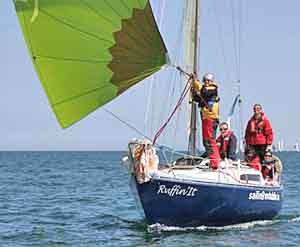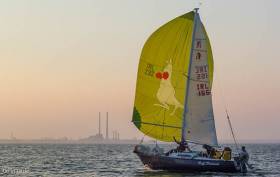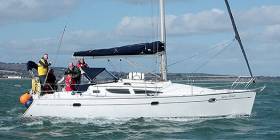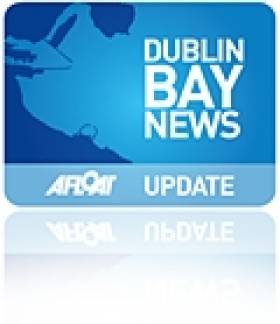Displaying items by tag: Sailing in Dublin Club (SID)
Sailing In Dublin, the Dun Laoghaire Harbour-based boat sharing club has announced its summer cruising schedule for 2022.
This year SID members will cruise their Sun Odyssey, Silver Wind around Ireland, in Scottish waters, and also to Cornwall for some island hopping in the Isles of Scilly. Along the way, they plan to stop at the Isle of Man and in Wales.
"SID offers sailors a cost-effective way of going cruising, without the hassle of boat ownership or chartering. You simply book a place on one or more cruising weeks of your choice", says the club's Nick Miller.
Silver Wind heads off to Scotland on June 4th and will be cruising right up until the end of August, so there’s bound to be a week that suits.
 Sailing in Dublin members moored off Sandycove on Dublin Bay
Sailing in Dublin members moored off Sandycove on Dublin Bay
As well as relaxing weeks spent cruising around one region, the schedule also includes some mile-building weeks and open-water legs for anyone looking to build up experience.
Annual membership is from as low as €390, giving access to the club’s fleet of keelboats and dinghies.
The SID ethos is that everyone gets a chance to helm and crew, offering unrivalled opportunities to build up experience.
Sailing in Dublin Club on the Airwaves
In a year when sailing will share the limelight with the other sports in the Olympics, the more leisurely and local aspects of the sport received some well-deserved coverage when RTE journalist Marie Louise O'Donnell was recently invited to try her hand at sailing by members of Sailing in Dublin Club.
Taking advantage of fine weather and mild wind, the reporter from Radio 1's Today with Sean O'Rourke show was brought on an evening cruise around Dublin Bay on the club's Sigma 33 ‘Obsession’. Marie Louise is known for her enthusiastic reporting and she was clearly bowled over by the experience as she gave a glowing report of her sail, including references as broad as Christopher Columbus, James Joyce and Dun Laoghaire's new Library. Regular skipper Linda French brought Obsession out into the Bay to give Marie Louise a closer look at a Dutch sail training vessel that was in Dublin for the riverfest and to look at boats racing as part of regular Thursday Dublin Bay Sailing Club race series.
In her radio package, Marie Louise described her experience in some detail including her introduction to knots and sheets and sailing terminology. But the experience of being on the water and of seeing Dublin from a different perspective seems to have impressed her the most. The journalist also had time to talk to the crew, comprising of well-seasoned SID members but also some newer members, who explained how they had benefited from joining the club.
Sailing in Dublin (SID) is currently engaged in a publicity drive to encourage more people to try the sport by sailing on one of the club owned boats; SID yachts include a Sigma 33, a Ruffian and the club cruiser, a Jeanneau Sun Odysessy. The club also has 4 Laser Vago dinghies and recently held several Try Sailing events on its keelboats and dinghies in conjunction with the Irish Sailing Association which was a great success.
The club's unique approach to sailing allows members to sail on a regular basis without the need to purchase their own boat, opening up a wide range of sailing opportunities at the fraction of the usual cost. You can listen to Marie Louise's report here and to arrange a guest sail to try out the club contact the SID Guest Liaison Officer at [email protected] or 085 8155 948
Sailing In Dublin Club Plan 'Leisurely' Round Ireland Cruise
The Sailing In Dublin (SID) Club AGM was held in the National Yacht Club on Thursday 7th April. There were presentations from the Club Chairperson Aine Kennedy and other club officers covering last year’s activities and plans for 2016.
In 2015 the Club saw the successful introduction of a new cruising yacht “Silver Wind” a Sun Odyssey-35. Silver Wind cruised to the South West coast last year and accommodated many members on week long cruises over a 10 week period. The Club Sigma 33 “Obsession” took part in ISORA races and the popular DBSC Turkey shoot and Spring Chicken racing series and also other leisurely sailing in Dublin Bay and beyond. The Club’s Ruffian 23 “Ruff Diamond” took part in DBSC racing and regattas.
The Club also has an active fleet of Vago dinghies which competed in DBSC racing, in the DMYC frostbite and dinghy cruises. Plans for 2016 include purchase of new equipment, increased participation of new and existing members in Dinghy, Cruising, Racing and training activities including a leisurely 14 week circumnavigation cruise around Ireland on the club yacht "Silver Wind" and continued participation in ISORA and DBSC racing.
Sailing In Dublin Club is based in Dun Laoghaire and provides a fleet or yachts and dinghies for adult members of all levels to take part in regular sailing activities.
New Yacht Sees 'Sailing in Dublin' Club on Crest of a Wave
#sid – Sailing in Dublin Club (SID Club) has just acquired an additional cruising boat to add to its growing fleet writes Jessica O'Donnell. Silver Wind, a 35ft Sun Odyssey boat, was purchased thanks to the assistance of a grant from the Government's Sports Capital scheme with the balance paid from Club funds. SID put together dedicated grant and boat acquisition sub-committees drawn from club members and they put much hard work into securing this important new acquisition. The new boat, which was purchased with the aim of increasing participation in sailing, has been enthusiastically welcomed by SID's growing club membership.
Since its foundation thirty years ago, Sailing in Dublin Club has gone from strength to strength and its current fleet includes Laser Vagos; Ruff Diamond, a Ruffian 23; Obsession, a Sigma 33 boat, and now an additional cruising boat, Silver Wind. As a sailing collective, SID offers wonderful opportunities for racing and cruising without someone having to own their own boat. Its volunteer ethos means that there is also a pool of members to also draw upon to help with, and therefore offering more opportunities to learn more about, boat maintenance.
SID regularly participates in the DBSC series of races throughout the year, races in the challenging Irish Offshore ISORA races as well as Regattas in Dun Laoghaire and elsewhere close to Dublin. The Club's cruising ambitions have grown impressively and in 2015 SID has an exciting cruising programme which will see members sail in cruises along the east, south and west coast of Ireland stopping off in the likes of Dunmore East, Crosshaven, Baltimore, Dingle and Galway along the way. There are also plenty of shorter cruises and days sails closer to home against the backdrop of stunning Dublin Bay. With the new boat, there is now even more comfort and enhanced features for members when cruising. This cruising aspect is only one part of a vibrant club that also has an active dinghy section so there is certainly something for everyone!
While not a sailing school, there is a strong emphasis in SID on encouraging members to up-skill through their participation in recognised sail training provided by sailing schools around Ireland and abroad. A volunteer Training Officer and training sub-committee regularly update members on the availability of approved sail training courses whether related to VHF, First Aid, Sea Survival skills, operating a powerboat or other relative subjects. Club members, too, are happy to share their skills with others on different rungs of the sailing ladder and such co-operation and opportunities for sailing development from competent crew to skippering is one of the Club's most attractive features.
As a small and friendly club, there are opportunities for socializing after sails and throughout the year at Club dinners, BBQs and other events. With two female Commodores in succession the Club is also leading the way in promoting 'women on the water'. SID's excellent value – the annual membership subscription is only €370 – and variety and extent of sailing opportunities has seen the Club's membership grow impressively year on year. New members are always welcome and for anyone who would like to avail of a Guest Sail with SID, they can do so by going to the Club's website www.sailingindublin.ie The cost of a Guest Sail is only €40 and is redeemable against full membership subscription should a person wish to join the Club. With the bright evenings and summer approaching it is definitely time to get out sailing! To find out more about SID and what it has to offer click www.sailingindublin.ie
Sailing in Dublin Club (SID)
 Ruffin'It taking part in the 2008 Lambay Race, June 2008. Standing: Martina, Peter and Daniel, and sitting: Carlos and Mags
Ruffin'It taking part in the 2008 Lambay Race, June 2008. Standing: Martina, Peter and Daniel, and sitting: Carlos and Mags
Sailing In Dublin Club (SID)
Sailing in Dublin Club (SID) is a small friendly club based in Dun Laoghaire, Co. Dublin.
Founded thirty years ago, the Club offers the opportunity of sailing regularly without having
to buy a boat. SID provides a fleet of dinghies and three yachts for sailing activities -
including racing and cruising – for a very competitive and affordable membership
subscription fee. The club welcomes adults who wish to enjoy sailing in Dublin Bay and
beyond.
If you are a beginner, you can sail on the club's 33ft Sigma and 23ft Ruffian keelboats with
experienced crew to build up your sailing skills and knowledge. If you have some sailing
experience, you can spend more time on the water dinghy sailing, on SID's 35ft cruising boat
Silver Wind, or on our keelboats where you can take part in all aspects of sailing, from
crewing to helming to navigation. SID gives you the opportunity of sailing with more
experienced sailors to build on sail training courses you may have taken elsewhere, or
perhaps before committing yourself to buying a boat.
Along with day sails in Dublin Bay and cruises further afield, all members are encouraged to
take part in races and regattas held in Dun Laoghaire during the summer months and the
'frostbite' series held on Sundays during the winter. Reflective of the club's voluntary ethos,
members take part in all aspects of running and organising the club and help with boat
maintenance. Boats, rescue cover and safety equipment are provided. Guest sails with the
club are available for those wishing to see what the club has to offer before joining as a full
member. The cost of a guest sail is redeemable against the full membership fee.
Regular weekend dinghy and yacht day sails and races continue over winter months subject
to suitable weather conditions. Club members are also encouraged to up-skill by
participating in on-shore training courses, attending talks. There are also opportunities for
socialising after sails as well as through Club dinners and other social events.
Club membership runs from January 1st to December 31st. In 2015 the annual membership
fee is €370. For details of any special offers throughout the year keep an eye on the Club's
website.
Further information on Sailing in Dublin Club and details of how to join can be found by
going to www.sailingindublin.ie or by contacting the SID Membership Secretary, Email:
www.facebook.com/sailingindublin


























































